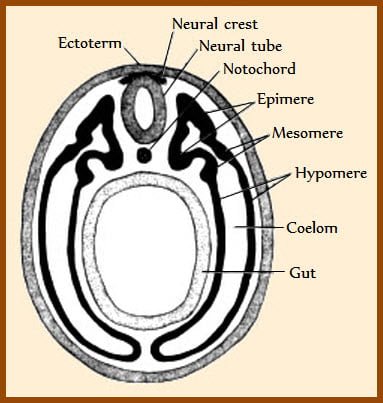TABLE OF CONTENTS
Development of Head Region in animals
Neural Plate and neural groove
The first indication of the formation of the head is a thickening of the ectoderm over the cranial end of the notochord. The thickening is the precursor of the brain which is referred as neural plate.
The folds develop from neural plate fuse with one another forming the neural tube. The neural tube differentiates into the major parts of the brain.

Notochord
The notochord is a rod shaped aggregate of cells that extends along the entire length of the embryo. Although it does not form a major structure in the adult mammalian embryo, it is of great developmental significance.
It defines the cranial and caudal axis of the embryo and serves as the inductor for the formation of the central nervous system and head of the embryo.
It is located on the midline of the embryo just ventral to the developing neural tube. It is an organizing center for the formation of the vertebral bodies and the basal parts of the sphenoid and occipital bones.
Formation of Cylindrical Shape
The period in which the growth of the neural tube occurs, differential growth of all the layers of the embryo also occur. However, the growth of the neural ectoderm predominates.
The growth patterns are in such a way that the cranial end of the embryo grows up and forward so that it extends over the area just in front of the head area to fold back under the head ventrally. This folding is referred as head fold.
At the same time, there is lateral infolding of the ectoderm on each side of the embryo which also surround the underlying mesenchyme of the cranial end of the embryo. These two lateral folds fuse with one another ventrally resulting in a cylindrical outgrowth, the head.
These two morphogenic growth processes that form the head enclosing layers and structures present in the area namely, the neural plate and attached ectoderm. Between these two are the endoderm and mesenchymal cells. As a result, the head has an outer cylindrical form covered by ectoderm and an inner tube lined by endoderm. The inner tube is the future cranial part of the digestive tube called the foregut.
The head once formed is elongated by the continued growth and the folding of the area, which is just in front of the primitive knot. The elongation of the head is also facilitated initially by the regression of the primitive knot caudally due to the disappearance of the primitive streak.

